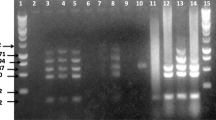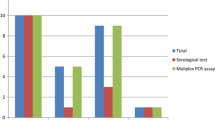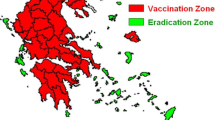Abstract
Brucellosis, caused by Brucella bacteria, is a common zoonotic infectious disease with various clinical manifestations in humans and animals. The disease is endemic in human and ruminant populations in Iran, with a particular prevalence in areas where humans have close interactions with livestock. Since domestic animals serve as the primary reservoir for brucellosis, this study aimed to identify the presence of Brucella spp. among aborted small ruminants in southeast Iran. Between 2021 and 2022, aborted fetuses of small ruminants (46 sheep and 4 goats) were collected from Zarand County in the Kerman province. Swab samples from the abomasum contents of these fetuses were obtained and subjected to DNA extraction. The samples were then tested for Brucella spp. detection using the polymerase chain reaction (PCR) method. Out of the 50 aborted fetuses examined, Brucella spp. was detected in 15 (30%) specimens, comprising 13 (28%) sheep and 2 (50%) goats. Species ty** revealed the presence of Brucella ovis (6 sheep and 1 goat), Brucella melitensis (6 sheep), and Brucella abortus (1 sheep) among the positive specimens. This cross-sectional study highlights the high prevalence of various Brucella species in samples from small ruminant abortions in southeast Iran. Additionally, the identified Brucella species were not limited to their primary host livestock. These indicated potential cross-species transmission among small ruminants.

Similar content being viewed by others
Data availability
All data generated or analyzed during this study are included in this published article.
References
Tekle M, Legesse M, Edao BM, Ameni G, Mamo G (2019) Isolation and identification of Brucella melitensis using bacteriological and molecular tools from aborted goats in the Afar region of north-eastern Ethiopia. BMC Microbiol 19(1):1–6
Golshani M, Buozari S (2017) A review of brucellosis in Iran: epidemiology, risk factors, diagnosis, control, and prevention. Iran Biomed J 21(6):349
de Figueiredo P, Ficht TA, Rice-Ficht A, Rossetti CA, Adams LG (2015) Pathogenesis and immunobiology of brucellosis: review of Brucella-Host interactions. Am J Pathol 185(6):1505–1517
Kurmanov B, Zincke D, Su W, Hadfield TL, Aikimbayev A, Karibayev T, Berdikulov M, Orynbayev M, Nikolich MP, Blackburn JK (2022) Assays for identification and differentiation of Brucella species: a review. Microorganisms 10(8):1584
Ezama A, Gonzalez J-P, Majalija S, Bajunirwe F (2018) Assessing short evolution brucellosis in a highly Brucella endemic cattle kee** population of Western Uganda: a complementary use of Rose Bengal test and IgM rapid diagnostic test. BMC Public Health 18(1):1–5
Abnaroodheleh F, Emadi A, Dadar M (2021) Seroprevalence of brucellosis and chlamydiosis in sheep and goats with history of abortion in Iran. Small Rumin Res 202:106459
Kolo FB, Fasina FO, Ledwaba B, Glover B, Dogonyaro BB, van Heerden H, Adesiyun AA, Katsande TC, Matle I, Gelaw AK (2018) Isolation of Brucella melitensis from cattle in South Africa. Vet Rec 182(23):668
Zeinali M, Doosti S, Amiri B, Gouya MM, Godwin GN (2022) Trends in the epidemiology of brucellosis cases in Iran during the last decade. Iran J Public Health 51(12):2791–2798
Bokaie S, Sharifi L, Alizadeh H, Advances V (2008) Epidemiological survey of brucellosis in human and animals in Birjand, east of Iran. J Anim Vet Adv 7(4):460–463
Dadar M, Alamian S, Behrozikhah AM, Yazdani F, Kalantari A, Etemadi A, Whatmore AM (2019) Molecular identification of Brucella species and biovars associated with animal and human infection in Iran. In: Vet Res Forum: 2019: Faculty of Veterinary Medicine, Urmia University, Urmia, Iran 315
Nazish A (2021) Fozia, Khattak B, Ali Khan T, Ahmad I, Ullah R, Bari A, Asmari MM, Mahmood HM, Sohaib M: Antinematode activity of Abomasum bacterial culture filtrates against Haemonchus contortus in small ruminants. Animals (Basel) 11(6):1843
Hinić V, Brodard I, Thomann A, Cvetnić Ž, Makaya P, Frey J (2008) Abril C 2008 Novel identification and differentiation of Brucella melitensis, B. abortus, B. suis, B. ovis, B. canis, and B. neotomae suitable for both conventional and real-time PCR systems. J Microbiol Methods 75(2):375–378
Mellado M, Valdez R, Lara L, Garcıa J (2004) Risk factors involved in conception, abortion, and kidding rates of goats under extensive conditions. Small Rumin Res 55(1–3):191–198
Aytekin I, Aypak SU (2011) production: Levels of selected minerals, nitric oxide, and vitamins in aborted Sakis sheep raised under semitropical conditions. Trop Anim Health Prod 43:511–514
Behzadi Shahrbabak MJ (2019) A review on infectious agents of sheep and goats abortion in Iran. NFVM 1(2):102–113
Roshan HM, Saadati D, Najimi M (2018) Molecular detection of Brucella melitensis, Coxiella burnetii and Salmonella abortusovis in aborted fetuses of Baluchi sheep in Sistan region, south-eastern Iran. Iran J Vet Res 19(2):128
Dadar M, Alamian S (2021) Identification of main Brucella species implicated in ovine and caprine abortion cases by molecular and classical methods. Arch Razi Inst 76(1):51
Fiebig A, Vrentas CE, Le T, Huebner M, Boggiatto PM, Olsen SC, Crosson S (2021) Quantification of Brucella abortus population structure in a natural host. Proc Natl Acad Sci U S A 118(11):e2023500118
Saleem MZ, Akhtar R, Aslam A, Rashid MI, Chaudhry ZI, Manzoor MA, Shah BA, Ahmed R (2019) Yasin MJPJZ: Evidence of Brucella abortus in non-preferred caprine and ovine hosts by real-time PCR assay. Pak J Zool 51:1187–1189
Ridler AL, West DM (2011) Control of Brucella ovis infection in sheep. Vet Clin North Am Food Anim Pract 27(1):61–66
Rossetti CA, Maurizio E, Rossi UA (2022) Comparative review of brucellosis in small domestic ruminants. Front Vet Sci 9:887671
Viana M, Shirima GM, John KS, Fitzpatrick J, Kazwala RR, Buza JJ, Cleaveland S, Haydon DT, Halliday JE (2016) Integrating serological and genetic data to quantify cross-species transmission: brucellosis as a case study. Parasitology 143(7):821–834
Hegazy YM, Abdel-Hamid NH, Eldehiey M, Oreiby AF, Algabbary MH, Hamdy ME, Beleta EI, Martínez I, Shahein MA, García N (2022) Trans-species transmission of Brucellae among ruminants hampering brucellosis control efforts in Egypt. J Appl Microbiol 132(1):90–100
Wang Y, Wang Z, Chen X, Zhang H, Guo F, Zhang K, Feng H, Gu W, Wu C, Ma L (2016) The complete genome of Brucella suis 019 provides insights on cross-species infection. Genes (Basel) 7(2):7
Wareth G, Melzer F, Tomaso H, Roesler U, Neubauer H (2015) Detection of Brucella abortus DNA in aborted goats and sheep in Egypt by real-time PCR. BMC Res Notes 8(1):1–5
Acknowledgements
We express our sincere appreciation and gratitude to the following organizations and departments for their invaluable contributions and support in conducting this study: the Department of Bacteriology at the Faculty of Veterinary Medicine of Shahid Bahoner Kerman University, the Department of Epidemiology and Biostatistics at the Pasteur Institute of Iran, the Reference and Bacteriology Laboratories of the Faculty of Veterinary Medicine of the Shahid Bahoner University of Kerman, the General Veterinary Department of the province, the veterinary network of Zarand city, and the veterinary treatment centers of the private sector of Zarand city.
Their collaboration and assistance were instrumental in carrying out our research successfully, and we are truly grateful for their support.
Funding
This research received funding from Shahid Bahonar University of Kerman (Kerman, Iran) as part of an MSc thesis grant.
Author information
Authors and Affiliations
Contributions
AA: conceptualization, data curation, investigation, methodology, software, validation, visualization, writing – original draft. MKh: conceptualization, data curation, funding acquisition, investigation, project administration, resources, supervision, validation, visualization. NB: investigation, methodology, writing – original draft, writing – review and editing. SE: conceptualization, investigation, resources, validation, writing – review and editing. EM.d: methodology. SK: methodology. All authors have read and agreed to the published version of the manuscript.
Corresponding authors
Ethics declarations
Ethics approval
This study was approved by the Research Ethics Committee of the Shahid Bahonar University of Kerman and Pasteur Institute of Iran (No. IR.PII.REC.1398.05). All methods and instructions were performed under institutional guidelines and regulations and were reported in accordance with ARRIVE guidelines (https://arriveguidelines.org) and the ethical standards laid down in the 1964 Declaration of Helsinki and its later amendments. Farmers permitted (with informed consent) their animal samples to be included in this study.
Competing interests
The authors declare no competing interests.
Additional information
Publisher's note
Springer Nature remains neutral with regard to jurisdictional claims in published maps and institutional affiliations.
Responsible Editor: Maria Aparecida Scatamburlo Moreira
Rights and permissions
Springer Nature or its licensor (e.g. a society or other partner) holds exclusive rights to this article under a publishing agreement with the author(s) or other rightsholder(s); author self-archiving of the accepted manuscript version of this article is solely governed by the terms of such publishing agreement and applicable law.
About this article
Cite this article
Alirezaei, A., Khalili, M., Baseri, N. et al. Molecular detection of Brucella species among aborted small ruminants in southeast Iran. Braz J Microbiol 55, 911–917 (2024). https://doi.org/10.1007/s42770-023-01191-z
Received:
Accepted:
Published:
Issue Date:
DOI: https://doi.org/10.1007/s42770-023-01191-z




